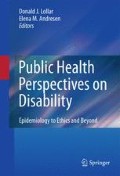Abstract
Disability affects a growing segment of the population of the United States and around the world, in part because the populations of the globe have enjoyed increasing age and decreasing infant mortality (Andresen, Cannell, Akhtar, & Barney, 2010). Public health professionals often have very little exposure to this increasing demographic group in our population during graduate training. With disability prevalence across surveys indicating some 20% of Americans with a disabling condition that limits activities, the health of this heterogeneous group must be included in the public health agenda and as part of public health education.
Access this chapter
Tax calculation will be finalised at checkout
Purchases are for personal use only
References
American Public Health Association. (2000). Eliminating access barriers in public health meetings. Policy Date: 1/1/2000. Policy Number: 200025. Online at http://www.apha.org/advocacy/policy/policysearch/default.htm?id=232.
Andresen, E. M. (2004). Public health education, research, and disability studies: a view from epidemiology (invited commentary). Disability Studies Quarterly, 24: Online at http://www.dsq-sds-archives.org/_articles_html/2004/fall/dsq_fall04_andresen.asp.
Andresen, E. M., Cannell, B., Akhtar, W., & Barney, K. F. (2010). Looming disease burden associated with the aging process. In: K. F. Barney & M. A. Perkinson (Eds). Occupational therapy with older/aging adults: enhancing quality of life through collaborative practice. Maryland Heights, MO: Elsevier.
Cahill, A. (2008). Emergency management and disability: a 2008 scorecard. Disability and Health Journal, 1, 125–126.
Campbell, V. A. (2000). State disability surveillance using the BRFSS. Presentation, CDC/Division of Birth Defects, Child Development, and Disability and Health. Atlanta, September 21.
Centers for Disease Control and Prevention. (1999). Ten great public health achievements-United States, 1900-1999. Morbidity and Mortality Weekly Report, 28(12), 1.
Centers for Disease Control and Prevention. (2000). State-specific prevalence of disability among adults – 11 states and the District of Columbia, 1998. Morbidity and Mortality Weekly Report, 50(7), 120–125.
DeFries, E. L., Andresen, E. M., & Classen. S. (2008). The intersection of public health data and rehabilitation practice. Topics in Geriatric Rehabilitation, 24, 185–191.
Domzal, C. (1995). Federal Statutory Definitions of Disability. Washington, DC: National Institute on Disability and Rehabilitation Research.
Health and Human Services. (1997). Healthy People 2000 Progress Review, People with Disabilities. Washington, DC: Public Health Service, 1–3.
Hough, J. F. (2000). Estimating the health care utilization costs associated with persons with disabilities: data from the 1996 Medical Expenditure Panel Survey (MEPS). Presentation at the Annual Meeting, Association for Health Services Research, Los Angeles, California, June 25.
Institute of Medicine. (1988). The Future of Public Health. Washington, DC: National Academy.
Institute of Medicine. (1991). Disability in America. Washington, DC: National Academy.
Institute of Medicine. (1997). Enabling America. Washington, DC: National Academy.
Institute of Medicine. (2003a). The Future of the Public’s Health in the 21st Century. Washington, DC: National Academy.
Institute of Medicine. (2003b). Who Will Keep the Public Healthy? Educating Public Health Professionals. Washington, DC: National Academy.
Lollar, D. J. (2002). Public health and disability: emerging opportunities. Public Health Reports, 117, 131–136.
Lollar, D. J. (2008). Rehabilitation psychology and public health: Commonalities, barriers, and bridges. Rehabilitation Psychology, 53, 122–127.
Lollar, D. J., & Crews, J. E. (2003) Redefining the role of public health in disability. Annual Review of Public Health, 24, 195–208.
Morbidity and Mortality Weekly Report. (2008). Racial/ethnic disparities in self-rated health status among adults with and without disabilities – United States, 2004–2006. Centers for Disease Control and Prevention, 57, 1069–1073.
National Center on Birth Defects and Developmental Disabilities, (2003). Disability and secondary conditions. in Healthy People 2010 Disability and Secondary Conditions Focus Area 6 Reports and Proceedings. Atlanta: CDC.
Rimmer. J. (2008). Disability forum reaches an important milestone – section status. APHA Section Newsletter (winter). Available from: URL (downloaded July 24, 2008) http://www.apha.org/membergroups/newsletters/sectionnewsletters/disability/winter08/disabilityforummilestone.htm.
Smith, D. L., & Notaro, S. J. (2009). Personal emergency preparedness for people with disabilities from the 2006-2007 Behavioral Risk Factor Surveillance System. Disability and Health Journal, 2, 86–94.
Tanenhaus, R. H., Meyers, A. R., & Harbison, L. A. (2000). Disability and the curriculum in US graduate schools of public health. American Journal of Public Health, 90, 1315–1316.
World Health Organization. (1997). Manual of the International Classification of Diseases, Injuries, and Causes of Death. Geneva: WHO.
World Health Organization. (2001). International Classification of Functioning, Disability, and Health: ICF. Geneva: WHO.
Author information
Authors and Affiliations
Corresponding author
Editor information
Editors and Affiliations
Rights and permissions
Copyright information
© 2011 Springer Science+Business Media, LLC
About this chapter
Cite this chapter
Lollar, D.J., Andresen, E.M. (2011). Introduction. In: Lollar, D., Andresen, E. (eds) Public Health Perspectives on Disability. Springer, New York, NY. https://doi.org/10.1007/978-1-4419-7341-2_1
Download citation
DOI: https://doi.org/10.1007/978-1-4419-7341-2_1
Published:
Publisher Name: Springer, New York, NY
Print ISBN: 978-1-4419-7340-5
Online ISBN: 978-1-4419-7341-2
eBook Packages: MedicineMedicine (R0)

